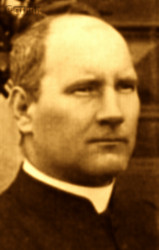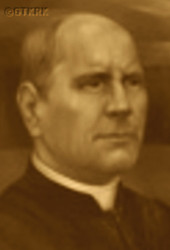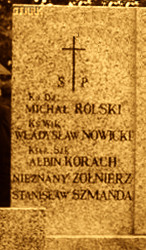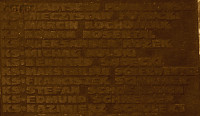Roman Catholic
St Sigismund parish
05-507 Słomczyn
85 Wiślana Str.
Konstancin deanery
Warsaw archdiocese, Poland
full list:
displayClick to display full list

searchClick to search full list by categories
wyświetlKliknij by wyświetlić pełną listę po polsku

szukajKliknij by przeszukać listę wg kategorii po polsku

Martyrology of the clergy — Poland
XX century (1914 – 1989)
personal data
surname
RÓLSKI
forename(s)
Michael (pl. Michał)
function
diocesan priest
creed
Latin (Roman Catholic) Church RCmore on
en.wikipedia.org
[access: 2014.09.21]
diocese / province
Gniezno and Poznań archdiocese (aeque principaliter)more on
www.archpoznan.pl
[access: 2012.11.23]
honorary titles
Ad Honores Spiritual Counselor
(05.09.1922)
date and place
of death
21.09.1939

Świerkówiectoday: Mogilno gm., Mogilno pov., Kuyavia‐Pomerania voiv., Poland
more on
en.wikipedia.org
[access: 2021.12.18]
alt. dates and places
of death
10.09.1939, 19.09.1939
details of death
After the German invasion of Poland on 01.09.1939 (the Russians invaded Poland 17 days later) and the start of World War II, his parish Szczepano village was captured by Germans — units of the Germ. 169. Infanterie Regiment (Eng. 169th Infantry Regiment), part of the Germ. 4. Armee (Eng. 4th Army) of the Germ. Wehrmacht (Eng. Armed Forces) — on 11.11.1939. The German occupation began.
Power in the district town of Mogilno, c. 22 km away, was taken over by the German military administration, supported by the genocidal Germ. Einsatzgruppen (Eng. Operational Groups), a formation of the Germ. Sicherheitspolizei (Eng. Security Police), i.e. SiPo, and the Germ. Sicherheitsdienst des Reichsführers SS (Eng. Security Service of the Reichsführer SS), i.e. SD, subordinated to the Germ. Reichssicherheitshauptamt (Eng. Reich Main Security Office), i.e. RSHA, and manned by the members of paramilitary, genocidal Germ. Die Schutzstaffel der NSDAP (Eng. NSDAP Protection Unit), i.e. «SS», subordinate to the National Socialist German Workers' Party NSDAP, whose task was to combat „all elements hostile to the Reich and Germany on enemy soil behind the fighting army”. The Germ. Einsatzgruppen carried out the Germ. Unternehmen «Tannenberg» (Eng. Operation „Tannenberg”), which was de facto the first phase of the Germ. «Intelligenzaktion» (Eng. „Intelligence Action”), i.e. the extermination of the Polish intelligentsia and leadership layers of occupied Poland.
Initially in Mogilno, prob. one of the Germ. Einsatzkommandos of the Germ. Einsatzgruppen IV unit, assigned to the Germ. 4. Armee, was active but it prob. quickly handed over its duties to units of the Germ. Einsatzgruppen VI, under the command of SS‐Oberführer Erich Naumann, which operated in the Germ. Militärbezirk Posen (Eng. Poznań Military District), i.e., the German‐occupied region of Greater Poland.
Repressions began — for example, as early as 14.09.1939, radio receivers were appropriated from residents.
Arrested by the Germans — prob. by the Germ. Wehrmacht, assisted by a Germ. Einsatzgruppen unit from Mogilno, or the Germ. Geheime Staatspolizei (Eng. Secret State Police), i.e. Gestapo, installing itself in the Mogilno district — on 19.09.1939, together with his vicar, Fr Vladislav Nowicki, and several other residents of Szczepanowo parish. During the arrest, the Germans ransacked the rectory.
His name was likely on one of the so‐called Germ. Sonderfahndungsliste (Eng. Special Wanted List) prepared before the German aggression, or on another proscription list, drawn up ad hoc based on denunciations from local Germ. Volksdeutsche (Eng. Ethnic Germans), i.e. representatives of the German minority in Poland. According to various sources, by early 09.1939, such lists might have contained details of 61,000‐88,000 „dangerous” Poles — although this could not be confirmed.
The basis for his arrest was, however, a verdict issued by the Germ. Polizeistandgericht (Eng. Police Summary Courts) established in occupied Greater Poland, operating within the Germ. Einsatzgruppen. Got included in a group that also comprised i.a. members of the Citizens' Guard, established in Mogilno on 06.09.1939. This group consisted of residents of the town and surrounding area, which offered armed resistance to Germ. Wehrmacht units on 09‐11.09.1939.
Taken to the detention center in Pakość, c. 12 km from Szczepanów.
Then, on 21.09.1939, transported to Mogilno.
Immediately afterwards herded to the execution site.
The murders — under the direction of the Germ. Wehrmacht — were carried out in the fields of the Świerkowiec estate (today within the town limits), c. 2 km from the center of Mogilno.
As was being led to his death, was said to have kneeled in front of the orphanage in Mogilno, before the statue of Our Lady, and prayed: „Mother of God, I beg you, grant me an easy death and victory for Poland!”.
A witness described the massacre as follows: „For three days, those shot were led in groups of 22‐24 people, along the path from Mogilno, all with their hands tied behind their backs. Fr Michael Rólski was in the first group on 21.09.1939. On the way, the dean encouraged the spirits of his fellow prisoners, encouraging them to offer their lives to God for the Fatherland, because apparently God demands such a sacrifice from them. Although they will no longer be, Poland was and Poland will be. The last words, 'Poland was and Poland will be', were repeated loudly and repeatedly by all the companions in misfortune. These shouts caused fury among the executioners and particular harassment towards Fr Rólski. The brave priest‐an old man‐incited everyone to repent for their sins, and he would grant absolution to the contrite ones. All were led in groups of four to the dug grave and were killed with a series from a machine gun. Those still alive were finished off with individual shots and massacred with spades. After the execution, the mass grave was filled in”.
According to some sources, shots were also fired into the already filled death pit, „because the earth was still moving”.
On the Świerkowiec estates, on 21‐24.09.1939, the Germans murdered c. 49 Poles in mass murders, including the aforementioned Fr Vladislav Nowicki, and three days later Fr Zenon Niziółkiewicz from the neighboring parish of Słaboszewo. Till 26.10.1939, when the German army handed over the management of the occupation district to the civilian authorities, the Germans murdered there a total of c. 117 Poles.
cause of death
mass murder
perpetrators
Germans
sites and events
ŚwierkówiecClick to display the description, «Intelligenzaktion»Click to display the description, Ribbentrop‐MolotovClick to display the description, Pius XI's encyclicalsClick to display the description
date and place
of birth
28.07.1862

Trzemesznotoday: Trzemeszno gm., Gniezno pov., Greater Poland voiv., Poland
more on
en.wikipedia.org
[access: 2021.07.18]
parents
RÓLSKI Luke
🞲 ?, ? — 🕆 ?, ?

ŚWITALSKA Mary
🞲 ?, ? — 🕆 ?, ?
baptism
17.08.1962

Trzemesznotoday: Trzemeszno gm., Gniezno pov., Greater Poland voiv., Poland
more on
en.wikipedia.org
[access: 2021.07.18]
Blessed Virgin Mary of the Assumption RC church
presbyter (holy orders)
ordination
14.03.1891

Gnieznotoday: Gniezno urban gm., Gniezno pov., Greater Poland voiv., Poland
more on
en.wikipedia.org
[access: 2021.12.18]
Assumption of the Blessed Virgin Mary RC archcathedral churchmore on
en.wikipedia.org
[access: 2025.03.14]
positions held
1924 – 1939
dean — Żnintoday: Żnin gm., Żnin pov., Kuyavia‐Pomerania voiv., Poland
more on
en.wikipedia.org
[access: 2021.06.20] RC deanery
06.1922 – 1939
parish priest — Szczepanowotoday: Dąbrowa gm., Mogilno pov., Kuyavia‐Pomerania voiv., Poland
more on
en.wikipedia.org
[access: 2021.06.20] ⋄ St Bartholomew the Apostle RC parish ⋄ Żnintoday: Żnin gm., Żnin pov., Kuyavia‐Pomerania voiv., Poland
more on
en.wikipedia.org
[access: 2021.06.20] RC deanery — also: member of the Priestly Union „Unitas”; member of the Society of Friends of Fine Arts in Krakow
27.02.1921 – 1922
deputy dean — Gniewkowotoday: Gniewkowo gm., Inowrocław pov., Kuyavia‐Pomerania voiv., Poland
more on
en.wikipedia.org
[access: 2020.11.27] RC deanery — i.e. 2nd deanery assessor, i.e. dean's assistant in the office
10.05.1894 – 1922
parish priest — Góratoday: Inowrocław gm., Inowrocław pov., Kuyavia‐Pomerania voiv., Poland
more on
en.wikipedia.org
[access: 2021.07.18] ⋄ Holy Trinity RC parish ⋄ Gniewkowotoday: Gniewkowo gm., Inowrocław pov., Kuyavia‐Pomerania voiv., Poland
more on
en.wikipedia.org
[access: 2020.11.27] RC deanery — also: also: till c. 1914 deanery notary;patron of the Polish Workers' Society; on c. 1916 treasurer and member of the Management Board of the Savings and Credit Company in Góra; member of the Karol Marcinkowski Scientific Aid Society in the Inowrocław county; from 1899 extraordinary member of the Fraternal Aid Fund in Berlin, for Poles studying in Germany
from 10.1910
administrator — Ostrowite Prymasowskietoday: Witkowo gm., Gniezno pov., Greater Poland voiv., Poland
more on
en.wikipedia.org
[access: 2021.12.18] ⋄ St Martin the Bishop and Confessor RC parish ⋄ Trzemesznotoday: Trzemeszno gm., Gniezno pov., Greater Poland voiv., Poland
more on
en.wikipedia.org
[access: 2021.07.18] RC deanery — acting („ad interim”)
01.09.1892 – 02.1897
administrator — Pieranietoday: Dąbrowa Biskupia gm., Inowrocław pov., Kuyavia‐Pomerania voiv., Poland
more on
en.wikipedia.org
[access: 2021.07.18] ⋄ St Nicholas the Bishop and Confessor RC parish ⋄ Gniewkowotoday: Gniewkowo gm., Inowrocław pov., Kuyavia‐Pomerania voiv., Poland
more on
en.wikipedia.org
[access: 2020.11.27] RC deanery — acting („ad interim”)
01.09.1892 – 1894
administrator — Góratoday: Inowrocław gm., Inowrocław pov., Kuyavia‐Pomerania voiv., Poland
more on
en.wikipedia.org
[access: 2021.07.18] ⋄ Holy Trinity RC parish ⋄ Gniewkowotoday: Gniewkowo gm., Inowrocław pov., Kuyavia‐Pomerania voiv., Poland
more on
en.wikipedia.org
[access: 2020.11.27] RC deanery
30.04.1892 – 20.08.1892
vicar — Kościelecalso: Kościelec Kujawski
today: Pakość gm., Inowrocław pov., Kuyavia‐Pomerania voiv., Poland
more on
en.wikipedia.org
[access: 2020.11.01] ⋄ St Margaret the Virgin and Martyr RC parish ⋄ Inowrocławtoday: Inowrocław gm., Inowrocław pov., Kuyavia‐Pomerania voiv., Poland
more on
en.wikipedia.org
[access: 2021.07.18] RC deanery
till 29.04.1892
administrator — Gąsawatoday: Gąsawa gm., Żnin pov., Kuyavia‐Pomerania voiv., Poland
more on
en.wikipedia.org
[access: 2021.07.18] ⋄ St Nicholas the Bishop and Confessor RC parish ⋄ Żnintoday: Żnin gm., Żnin pov., Kuyavia‐Pomerania voiv., Poland
more on
en.wikipedia.org
[access: 2021.06.20] RC deanery
03.1891 – 1892
vicar — Gąsawatoday: Gąsawa gm., Żnin pov., Kuyavia‐Pomerania voiv., Poland
more on
en.wikipedia.org
[access: 2021.07.18] ⋄ St Nicholas the Bishop and Confessor RC parish ⋄ Żnintoday: Żnin gm., Żnin pov., Kuyavia‐Pomerania voiv., Poland
more on
en.wikipedia.org
[access: 2021.06.20] RC deanery
till 1891
student — Gnieznotoday: Gniezno urban gm., Gniezno pov., Greater Poland voiv., Poland
more on
en.wikipedia.org
[access: 2021.12.18] ⋄ philosophy and theology, Archbishop's Practical Theological Seminary (Lat. Seminarium Clericorum Practicum)
29.09.1889 – 04.1890
student — Poznańtoday: Poznań city pov., Greater Poland voiv., Poland
more on
en.wikipedia.org
[access: 2021.07.18] ⋄ philosophy and theology, Archbishop's Theological Seminary (Collegium Leoninum)
1887 – 1889
student — Münstertoday: Münster urban dist., Münster reg., North Rhine‐Westphalia state, Germany
more on
en.wikipedia.org
[access: 2021.07.18] ⋄ philosophy and theology, Theological Seminary — five semesters
till 1887
pupil — Chełmnotoday: Chełmno urban gm., Chełmno pov., Kuyavia‐Pomerania voiv., Poland
more on
en.wikipedia.org
[access: 2021.07.25] ⋄ Germ. Königliche Katholische Gymnasium (Eng. Royal Catholic Gymnasium) — studies completed with the maturity diploma (i.e. matura)
till 1881
pupil — Trzemesznotoday: Trzemeszno gm., Gniezno pov., Greater Poland voiv., Poland
more on
en.wikipedia.org
[access: 2021.07.18] ⋄ Germ. Königliche Progymnasium (Eng. Royal Progymnasium)
from 16.03.1916
membership — Poznańtoday: Poznań city pov., Greater Poland voiv., Poland
more on
en.wikipedia.org
[access: 2021.07.18] ⋄ management board, Friends of Sciences Society
others related
in death
NIZIÓŁKIEWICZClick to display biography Zeno, NOWICKIClick to display biography Vladislav
sites and events
descriptions
Świerkówiec: On Świerkówiec property n. Mogilno, on 21‐24.09.1939 in mass executions, Germans murdered c. 49 Poles, including at least 3 priests. They were brought to the execution site in groups, with their hands tide with wires behind their back. They were then gunned down and the injured were killed off and massacred with spades. In Mogilno in 09.1939 altogether 115 Poles were slaughtered by the Germans. (more on: pl.wikipedia.orgClick to attempt to display webpage
[access: 2012.11.23], www.mogilno.inClick to attempt to display webpage
[access: 2013.07.06])
«Intelligenzaktion»: German: «Intelligenzaktion» (English: „Intelligence Action”) — a German program of extermination of the Polish elite, mainly the intelligentsia and leadership layers, carried out from the beginning of the occupation in w 09.1939 to 04.1940, mainly in territories directly annexed to Germany, but also in the so‐called Germ. Generalgouvernement (Eng. General Governorate), where it was called «AB‐aktion». In the first phase, immediately after the beginning of the German occupation, during military operations carried out by the Germ. Wehrmacht (Eng. Armed Forces) and the genocidal units of the Germ. Einsatzgruppen (Eng. Operational Groups) of the Germ. Sicherheitspolizei (Eng. Security Police), i.e. SiPo, and Germ. Sicherheitsdienst des Reichsführers SS (Eng. Security Service of the Reichsführer SS), i.e. SD, organized by the Germ. Reichssicherheitshauptamt (Eng. Reich Main Security Office), i.e. RSHA, which followed the troops, carried out under the Germ. Unternehmen „Tannenberg” (Eng. Operation „Tannenberg”) — based on the so‐called Germ. Sonderfahndungsliste (Eng. Special Wanted Lists), i.e. proscription lists of Poles considered particularly dangerous to the Third Reich, prepared by the Zentralstelle II/P (Polen) unit of the German RSHA. Later, implemented by the German civilian occupation authorities and the genocidal unit of the Germ. Volksdeutscher Selbstschutz (Eng. Ethnic Germans Self‐Defense), whose members were Germ. Volksdeutsche (Eng. Ethnic Germans), i.e. representatives of the German minority in Poland. According to various sources, these lists, at the beginning of 09.1939, could have contained the details of 61,000—88,000 „dangerous” Poles — although these figures cannot be confirmed. In total, during this genocide, c. 50,000 teachers, Catholic priests, representatives of the landed gentry, freelancers, social and political activists, and retired military personnel were systematically and methodically murdered. Another 50,000 were sent to concentration camps, where only a negligible percentage survived. (more on: en.wikipedia.orgClick to attempt to display webpage
[access: 2014.10.04])
Ribbentrop‐Molotov: Genocidal Russian‐German alliance pact between Russian leader Joseph Stalin and German leader Adolf Hitler signed on 23.08.1939 in Moscow by respective foreign ministers, Mr. Vyacheslav Molotov for Russia and Joachim von Ribbentrop for Germany. The pact sanctioned and was the direct cause of joint Russian and German invasion of Poland and the outbreak of the World War II in 09.1939. In a political sense, the pact was an attempt to restore the status quo ante before 1914, with one exception, namely the „commercial” exchange of the so‐called „Kingdom of Poland”, which in 1914 was part of the Russian Empire, fore Eastern Galicia (today's western Ukraine), in 1914 belonging to the Austro‐Hungarian Empire. Galicia, including Lviv, was to be taken over by the Russians, the „Kingdom of Poland” — under the name of the General Governorate — Germany. The resultant „war was one of the greatest calamities and dramas of humanity in history, for two atheistic and anti‐Christian ideologies — national and international socialism — rejected God and His fifth Decalogue commandment: Thou shall not kill!” (Abp Stanislav Gądecki, 01.09.2019). The decisions taken — backed up by the betrayal of the formal allies of Poland, France and Germany, which on 12.09.1939, at a joint conference in Abbeville, decided not to provide aid to attacked Poland and not to take military action against Germany (a clear breach of treaty obligations with Poland) — were on 28.09.1939 slightly altered and made more precise when a treaty on „German‐Russian boundaries and friendship” was agreed by the same murderous signatories. One of its findings was establishment of spheres of influence in Central and Eastern Europe and in consequence IV partition of Poland. In one of its secret annexes agreed, that: „the Signatories will not tolerate on its respective territories any Polish propaganda that affects the territory of the other Side. On their respective territories they will suppress all such propaganda and inform each other of the measures taken to accomplish it”. The agreements resulted in a series of meeting between two genocidal organization representing both sides — German Gestapo and Russian NKVD when coordination of efforts to exterminate Polish intelligentsia and Polish leading classes (in Germany called «Intelligenzaktion», in Russia took the form of Katyń massacres) where discussed. Resulted in deaths of hundreds of thousands of Polish intelligentsia, including thousands of priests presented here, and tens of millions of ordinary people,. The results of this Russian‐German pact lasted till 1989 and are still in evidence even today. (more on: en.wikipedia.orgClick to attempt to display webpage
[access: 2015.09.30])
Pius XI's encyclicals: Facing the creation of two totalitarian systems in Europe, which seemed to compete with each other, though there were more similarities than contradictions between them, Pope Pius XI issued in 03.1937 (within 5 days) two encyclicals. In the „Mit brennender Sorge” (Eng. „With Burning Concern”) published on 14.03.1938, condemned the national socialism prevailing in Germany. The Pope wrote: „Whoever, following the old Germanic‐pre‐Christian beliefs, puts various impersonal fate in the place of a personal God, denies the wisdom of God and Providence […], whoever exalts earthly values: race or nation, or state, or state system, representatives of state power or other fundamental values of human society, […] and makes them the highest standard of all values, including religious ones, and idolizes them, this one […] is far from true faith in God and from a worldview corresponding to such faith”. On 19.03.1937, published „Divini Redemptoris” (Eng. „Divine Redeemer”), in which criticized Russian communism, dialectical materialism and the class struggle theory. The Pope wrote: „Communism deprives man of freedom, and therefore the spiritual basis of all life norms. It deprives the human person of all his dignity and any moral support with which he could resist the onslaught of blind passions […] This is the new gospel that Bolshevik and godless communism preaches as a message of salvation and redemption of humanity”… Pius XI demanded that the established human law be subjected to the natural law of God , recommended the implementation of the ideal of a Christian state and society, and called on Catholics to resist. Two years later, National Socialist Germany and Communist Russia came together and started World War II. (more on: www.vatican.vaClick to attempt to display webpage
[access: 2023.05.28], www.vatican.vaClick to attempt to display webpage
[access: 2023.05.28])
sources
personal:
www.wtg-gniazdo.orgClick to attempt to display webpage
[access: 2012.11.23], www.scribd.comClick to attempt to display webpage
[access: 2012.11.23], www.przewodnik-katolicki.plClick to attempt to display webpage
[access: 2016.08.14], gosc.plClick to attempt to display webpage
[access: 2016.08.14], www.academia.eduClick to attempt to display webpage
[access: 2025.11.05]
original images:
spszczepanowo.plClick to attempt to display webpage
[access: 2015.09.30], gosc.plClick to attempt to display webpage
[access: 2016.08.14], www.archidiecezja.plClick to attempt to display webpage
[access: 2015.09.30]
LETTER to CUSTODIAN/ADMINISTRATOR
If you have an Email client on your communicator/computer — such as Mozilla Thunderbird, Windows Mail or Microsoft Outlook, described at WikipediaPatrz:
en.wikipedia.org, among others — try the link below, please:
LETTER to CUSTODIAN/ADMINISTRATORClick and try to call your own Email client
If however you do not run such a client or the above link is not active please send an email to the Custodian/Administrator using your account — in your customary email/correspondence engine — at the following address:

giving the following as the subject:
MARTYROLOGY: RÓLSKI Michael
To return to the biography press below:
 Click to return to biography
Click to return to biography












